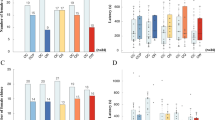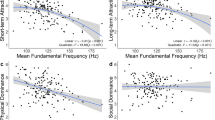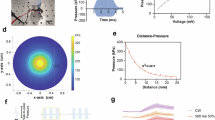Abstract
Acoustic communication plays an important role in the reproductive behavior of anurans. Males of concave-eared torrent frog (_Odorrana tormota_) have ultrasonic communication capacity 1, 2, but it is unknown whether females communicate with ultrasound. Here we show that O. tormota exhibits great sex differences in the auditory frequency sensitivity. Acoustic playback experiments demonstrated that the male's advertisement calls evoke gravid females' positive phonotaxis and vocal responses, whereas ultrasonic components of the male's calls (frequencies above 20 kHz) do not elicit female phonotaxis or vocalization. The behavioral study was complemented by electrophysiological recordings from the auditory midbrain and by laser Doppler vibrometer measurements of the tympanic membrane's response to acoustic stimuli. These measurements revealed that females have an upper frequency limit up to 16 kHz (threshold 107 dB SPL) and no ultrasound sensitivity, unlike males which have an upper frequency limit of up to 35 kHz (87 dB SPL). Single units in the female auditory midbrain have the best excitatory frequencies (BEFs) peaked around 5 kHz, corresponding to the fundamental frequency (F0) of male's most calls, whereas the male auditory midbrain units have BEFs mostly above 8 kHz, largely consistent with the F0 of female courtship calls. Females have a frequency sensitive bandwidth (10 dB above threshold) ranged from 2 to 6 kHz, narrower than that males have (5-20 kHz). The velocity amplitude of the tympanic membranes peaked around 5 kHz in females, whereas 7 kHz in males. The results suggest that the frog species O. tormota is an example of a vertebrate, which demonstrates well phonotaxis and extraordinary sex differences in hearing.
Similar content being viewed by others
Article PDF
Author information
Authors and Affiliations
Corresponding author
Rights and permissions
About this article
Cite this article
Shen, JX., Xu, ZM., Yu, ZL. et al. Ultrasonic frogs show extraordinary sex differences in auditory frequency sensitivity. Nat Prec (2010). https://doi.org/10.1038/npre.2010.5337.1
Received:
Accepted:
Published:
DOI: https://doi.org/10.1038/npre.2010.5337.1



